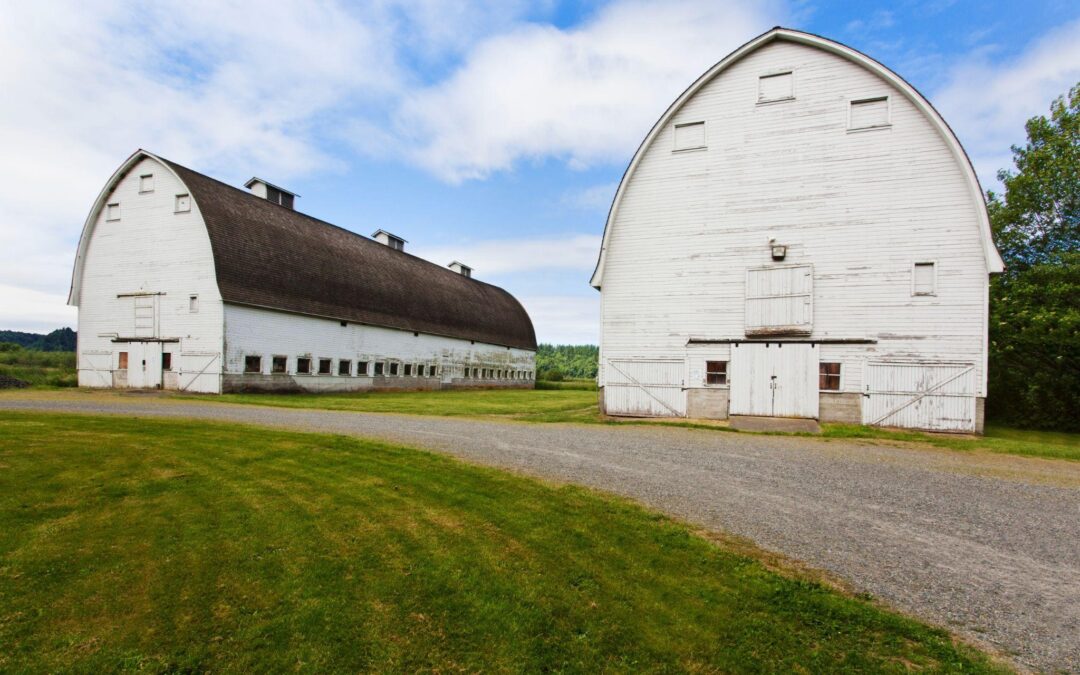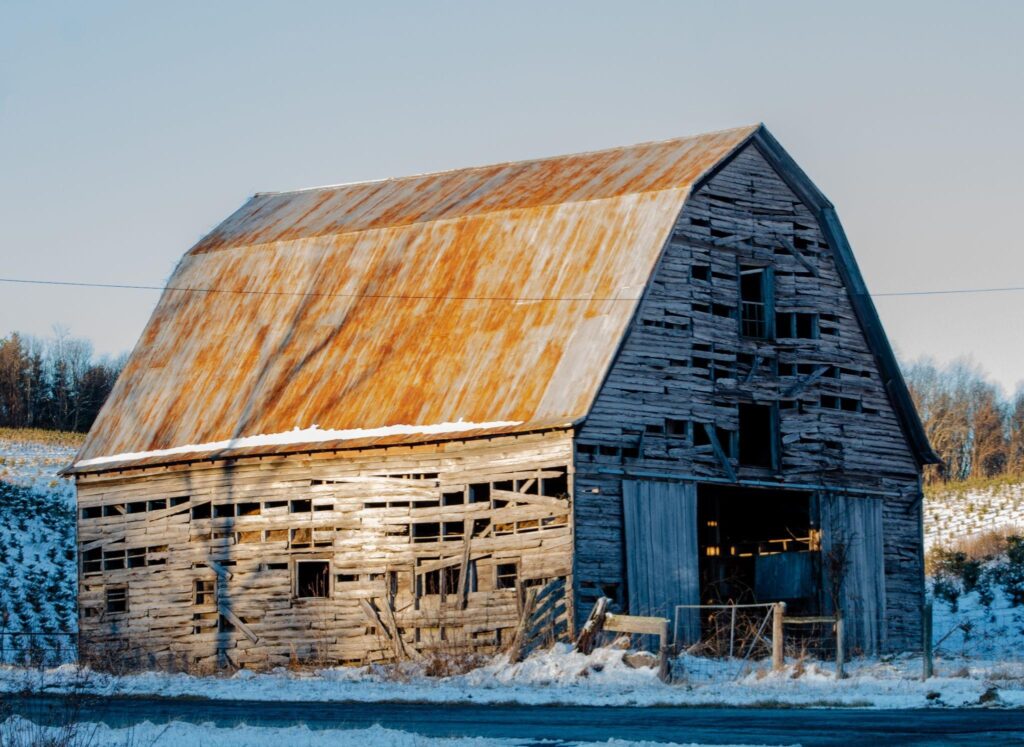The short answer: most barns can last 40 to 100 years, but only if they’re properly maintained.
Leaks, rot, and shifting foundations can quietly shorten that lifespan by decades. Many owners overlook small issues until they become big, costly problems. A few loose boards or a damp corner might not seem urgent until a beam sags or a wall starts to lean.
The good news?
You can catch and fix these issues early. And with the right repairs or a well-planned remodel, your barn could stay strong for generations.
In this post, you’ll learn what causes barns to break down, what helps them last, and when it’s time to take action.
Timeline: What to Expect at Each Stage of a Barn’s Life
Every barn ages, and each stage brings new challenges. Knowing what to expect—and when to act—can help you keep your barn strong for the long haul.
0–20 Years: Solid and Strong
At this stage, your barn is new and in great shape. The frame, roof, and siding don’t need much more than a routine checkup.
To keep it that way:
- Watch for water pooling near the foundation
- Clear out gutters regularly
- Seal up any small cracks before they spread
These small tasks help prevent bigger issues and set your barn up for a long, healthy future.
Want to know what repairs or upgrades might cost later? Read How Much Does It Cost to Renovate a Barn? for a full breakdown.
20–40 Years: Wear and Tear Begins
Around the 20-year mark, signs of aging start to show. Your barn might still feel solid, but look closer.
Common issues include:
- Loose or curling roof shingles
- Warped boards on the siding
- Doors or windows that stick or won’t close properly
This is the best time to schedule a full inspection. Catching small problems early, like tightening joints or replacing damaged siding, can add another 10 to 15 years of use.
40–60 Years: Time to Rethink Repairs
By this point, your barn’s age is hard to ignore. You might notice:
- A sagging roofline
- Walls that lean or shift
- Soft, unstable flooring
At this stage, many barn owners ask: Is it worth patching again—or is it time to remodel?
In most cases, remodeling is the better long-term choice. You can keep the original structure, fix what’s failing, and upgrade it with stronger materials and better function.
60–100+ Years: Preserve or Repurpose
If your barn has made it this far, it was likely built well and cared for. However, major repairs are usually needed to keep it safe and useful.
This phase is the perfect time to:
- Reinforce or rebuild key structural elements
- Adapt the barn for a new purpose (guest house, event space, workshop)
- Preserve historical features while meeting modern safety standards
Barns this old have history and character that are hard to replace. With the right remodeling plan, they can keep going for decades more.
Not sure what to do with an aging structure? Check out Old Barn – What Should I Do With It? for ideas and expert advice.
What Hurts a Barn’s Lifespan
Some damage is easy to spot. Other problems hide until it’s too late. Below are the top reasons barns break down sooner than they should, and what signs to look for before things get worse.
1. Leaks in the Roof or Walls
Water is one of the biggest threats to your barn.
- A missing shingle or small hole might not seem serious, but water always finds a way in.
- Leaks can rot beams, soak insulation, damage flooring, and lead to mold.
What to look for:
- Dark stains on wood
- Soft or spongy spots on the walls or ceiling
- A musty smell inside the barn
2. Skipping Regular Maintenance
Small problems become big ones when they’re ignored.
- A cracked board today could mean a broken beam tomorrow.
- Failing to check the roof, siding, or foundation each year shortens the barn’s life.
What to look for:
- Loose panels or missing hardware
- Paint is peeling off quickly
- Gaps forming in corners or where walls meet the floor
3. Harsh Weather Without Protection
Wind, rain, snow, and sun wear down materials over time.
- Heavy snow puts pressure on your roof
- Sun dries out the wood, causing cracks
- Rain leads to moisture damage if the barn isn’t sealed well
What to look for:
- Bowed or sagging rooflines
- Cracks in beams or boards
- Siding that’s warped or starting to pull away
4. Pest Damage
Pests may be small, but they cause big problems.
- Termites eat wood from the inside out
- Mice chew through insulation and wires
- Birds can damage rafters and leave behind waste that spreads mold
What to look for:
- Piles of sawdust near wood posts (a sign of termites)
- Chewed wires or insulation in the walls
- Nesting materials or droppings in rafters and corners
5. Poor Drainage Around the Barn
If water collects near your barn instead of draining away, it’s a problem.
- Wet ground softens over time, causing the barn to shift or sink
- Excess moisture damages the foundation and attracts pests
What to look for:
- Standing water after it rains
- Mud or erosion near the base of the structure
- Cracks are forming at the foundation
These issues don’t just pop up overnight, but when they do, they move fast. The good news? Many of them are avoidable. Let’s talk next about what helps barns stand the test of time.
What Helps a Barn Last Longer
Even an older barn can stay in great shape if it’s cared for the right way. Here’s what protects your barn and helps it last for decades longer:
1. Regular inspections
Every year, walk around your barn inside and out. Look for signs of damage, leaks, rot, or loose parts.
- Catching problems early saves money.
- Make it a habit every spring and fall, especially after storms or heavy snow.
2. Keep the roof in great shape
The roof is the first line of defense against the weather.
- Check for loose or missing shingles.
- Replace rusted metal panels.
- Clean the gutters so water drains away from the barn.
3. Keep it dry and well-ventilated
Moisture is your barn’s biggest enemy.
- Install vents or fans if needed.
- Make sure doors and windows open easily to let air move through.
- A dry barn lasts much longer and is safer for animals and equipment.
4. Replace weak or damaged parts
If you spot a cracked beam or sagging floor, don’t ignore it.
- Replacing just a few weak pieces can stop a full collapse later.
- Wood that’s soft, moldy, or crumbling needs to be swapped out quickly.
5. Plan smart upgrades or remodeling
Eventually, repairs might not be enough. Remodeling can give your barn a fresh start.
- New siding, roofing, or stronger support beams add years to its life.
- Remodeling can also improve how the barn is used—turn it into a workspace, event space, or storage building.
Take Action: Extend Your Barn’s Lifespan Now
If your barn’s getting older or already showing signs of wear, don’t wait.
Small issues turn into big, expensive problems fast. The sooner you act, the more you save.
Ask yourself:
- Is the roof starting to sag?
- Are beams cracked or weakened?
- Do the doors stick, or is the siding falling off?
These aren’t just signs of age, they’re warnings. It’s time to stop patching and start planning.
A smart remodel can add decades to your barn’s lifespan. It’ll make your structure safer, stronger, and ready for whatever comes next.
Not sure where to begin? Woodford Barn Repair makes barn remodeling in New York simple, practical, and built to last.
Explore your remodeling options now.


